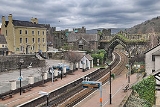
Conwy railway station
Encyclopedia
Conwy railway station serves the ancient walled town of Conwy
and is located on the Crewe
to Holyhead
North Wales Coast Line
. There are through services to Chester
via Colwyn Bay
, Rhyl
, Prestatyn
and Flint
in one direction and to Bangor & Holyhead in the other. After arrival at Chester, most trains go forward to either Crewe
, Cardiff
or Birmingham International
. The station was opened by the Chester and Holyhead Railway
on 1 May 1848, was closed as part of the Beeching cuts
on 14 February 1966 but reopened on 29 June 1987 as a request stop
. Upon reopening, the Welsh spelling Conwy was adopted, in contrast to the Anglicised form Conway used until closure in 1966.
Conwy
Conwy is a walled market town and community in Conwy County Borough on the north coast of Wales. The town, which faces Deganwy across the River Conwy, formerly lay in Gwynedd and prior to that in Caernarfonshire. Conwy has a population of 14,208...
and is located on the Crewe
Crewe railway station
Crewe railway station was completed in 1837 and is one of the most historic railway stations in the world. Built in fields near to Crewe Hall, it originally served the village of Crewe with a population of just 70 residents...
to Holyhead
Holyhead
Holyhead is the largest town in the county of Anglesey in the North Wales. It is also a major port adjacent to the Irish Sea serving Ireland....
North Wales Coast Line
North Wales Coast Line
The North Wales Coast Line is the railway line from Crewe to Holyhead. Virgin Trains consider their services along it to be a spur of the West Coast Main Line. The first section from Crewe to Chester was built by the Chester and Crewe Railway and absorbed by the Grand Junction Railway shortly...
. There are through services to Chester
Chester railway station
Chester railway station is a railway station in Newtown in the city of Chester, England. It is currently operated by Arriva Trains Wales, although Merseyrail, Northern Rail and Virgin Trains also run services from the station. It is situated to the north-east of the city centre...
via Colwyn Bay
Colwyn Bay
- Demography :Prior to local government reorganisation on 1 April 1974 Colwyn Bay was a municipal borough with a population of c.25,000, but in 1974 this designation disappeared leaving five separate parishes, known as communities in Wales, of which the one bearing the name Colwyn Bay encompassed...
, Rhyl
Rhyl
Rhyl is a seaside resort town and community situated on the north east coast of Wales, in the county of Denbighshire , at the mouth of the River Clwyd . To the west is the suburb of Kinmel Bay, with the resort of Towyn further west, Prestatyn to the east and Rhuddlan to the south...
, Prestatyn
Prestatyn
Prestatyn is a seaside resort, town and community in Denbighshire, North Wales. It is located on the Irish Sea coast, to the east of Rhyl. At the 2001 Census, Prestatyn had a population of 18,496.-Prehistory:...
and Flint
Flint
Flint is a hard, sedimentary cryptocrystalline form of the mineral quartz, categorized as a variety of chert. It occurs chiefly as nodules and masses in sedimentary rocks, such as chalks and limestones. Inside the nodule, flint is usually dark grey, black, green, white, or brown in colour, and...
in one direction and to Bangor & Holyhead in the other. After arrival at Chester, most trains go forward to either Crewe
Crewe railway station
Crewe railway station was completed in 1837 and is one of the most historic railway stations in the world. Built in fields near to Crewe Hall, it originally served the village of Crewe with a population of just 70 residents...
, Cardiff
Cardiff Central railway station
Cardiff Central railway station is a major railway station on the South Wales Main Line in Cardiff, Wales.It is the largest and busiest station in Wales and one of the major stations of the British rail network, the tenth busiest station in the United Kingdom outside of London , based on 2007/08...
or Birmingham International
Birmingham International railway station
Birmingham International railway station is located in the borough of Solihull, just east of the city of Birmingham in England.The station is on the Rugby-Birmingham-Stafford Line 14 km east of Birmingham New Street and serves both Birmingham International Airport and the National Exhibition...
. The station was opened by the Chester and Holyhead Railway
Chester and Holyhead Railway
The Chester and Holyhead Railway was incorporated out of a proposal to link Holyhead, the traditional port for the Irish Mail, with London by way of the existing Chester and Crewe Railway, and what is now the West Coast Main Line...
on 1 May 1848, was closed as part of the Beeching cuts
Beeching Axe
The Beeching Axe or the Beeching Cuts are informal names for the British Government's attempt in the 1960s to reduce the cost of running British Railways, the nationalised railway system in the United Kingdom. The name is that of the main author of The Reshaping of British Railways, Dr Richard...
on 14 February 1966 but reopened on 29 June 1987 as a request stop
Request stop
In public transport, a request stop or flag stop describes a stopping point at which trains or buses stop only on an as-need or request basis; that is, only if there are passengers to be picked up or dropped off. In this way, infrequently used stopping points can be served efficiently.Trains save...
. Upon reopening, the Welsh spelling Conwy was adopted, in contrast to the Anglicised form Conway used until closure in 1966.

